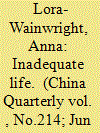| Srl | Item |
| 1 |
ID:
149930


|
|
|
|
|
| Summary/Abstract |
The Production Tax Credit (PTC) is an important policy instrument through which the federal government promotes renewable energy development in the United States. However, the efficacy of the PTC is hampered by repeated expirations and short-term extensions, and by the general uncertainty surrounding its future status. We examine the factors driving variation in public support for the extension of the PTC using a nationally representative, internet-based survey. Americans living near a coal-fired power plant are significantly more likely to support extending the PTC than are their peers who are more insulated from the externalities of burning coal. The evidence for this dynamic was strongest and most statistically significant among subjects experimentally primed to think about the adverse health effects of burning coal. Raising awareness of the public health ramifications of generating electricity from fossil fuels holds the potential to increase support for renewable energy policies among those living in proximity to coal plants, even in a highly politicized policy debate.
|
|
|
|
|
|
|
|
|
|
|
|
|
|
|
|
| 2 |
ID:
121205


|
|
|
|
|
| Publication |
2013.
|
| Summary/Abstract |
Based on fieldwork in a heavily industrialized Yunnan village, this article examines how villagers understand and respond to pollution-related health risks. Building on Robert Weller's (2006) concept of environmental consciousness, it shows that Baocun villagers have developed an acute environmental health consciousness. However, despite earlier instances of collective activism, they no longer act as a community to oppose the harm to their bodies caused by pollution. The article investigates the role of uncertainty surrounding illness causation in deterring action. It argues that uncertainty about pollution's effects on health is reinforced by the social, political and economic contexts and developments in the past few decades. As a result, villagers engage in a form of "lay epidemiology" to make sense of the effects of pollution on their health, but not in a "popular epidemiology" consisting of collective action against presumed health damages. The article concludes with some thoughts on how locals act within and despite uncertainty.
|
|
|
|
|
|
|
|
|
|
|
|
|
|
|
|
| 3 |
ID:
181797


|
|
|
|
|
| Summary/Abstract |
The implementation of China’s clean energy deployment policies has produced considerable benefits of ambient air quality improvement as well as the corresponding reduction of disease burden. However, few studies have focused on their quantification. In this study, we developed an integrated evaluation framework to assess the benefit of reduced disease burden resulting from the air quality improvement after the deployment of clean energy in Hebei Province, China. It was found that the pollutant emissions could be reduced by 18–45% and 33–66% under the General Policy (GP) and Strengthen Policy (SP) scenarios in 2030. The household sector has the largest reduction potential for all pollutant emissions, followed by the power sector with a considerable reduction effect on SO2 and NOx. The annual mean PM2.5 concentration was estimated to decrease from 52 μg m−3 under the Business as Usual (BAU) scenario to 40 μg m−3 under the SP scenario in 2030. Consequently, the disease burden due to air pollution would be reduced by 7499 and 12260 cases, respectively, under the GP and SP scenarios in 2030. Our study confirmed the effectiveness of clean energy deployment policies, and could provide scientific support and significant information to policymakers.
|
|
|
|
|
|
|
|
|
|
|
|
|
|
|
|